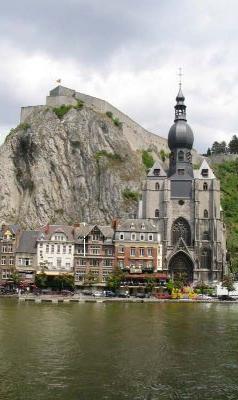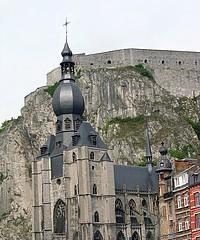%%rimage[Belgium: From Prince-Bishop to Napoleon's concordat]=X2151_727_NLBEDinantLogo_t55.jpg Belgium: From Prince-Bishop to Napoleon's concordat
The Church ruled over many European territories, not just the Papal States. There were dozens of prince-bishops in the former Holy Roman Empire, now Germany and some surrounding countries. For instance, the picturesque little town of Dinant in modern Belgium was ruled by Prince-Bishop of Liège. Naturally, where a cleric reigned, a concordat between the pope and the ruler was not necessary.
 Where church and state were one
Where church and state were one
The castle of the Prince-Bishop of Liège once looked down from the tall limestone cliff over the River Meuse. It has now been replaced by 19th-century fortress, but the little town of Dinant at its foot still clusters around the onion-domed Church of Notre-Dame. Throughout the Middle Ages the citizens of Dinant rebelled repeatedly against their spiritual and temporal overlord, but in vain. In 1466, for instance, the Prince-Bishop called in his uncle to put down an uprising. The Duke of Burgundy obliged his ecclesiastical nephew by laying siege to Dinant until it surrendered, then he massacred 800 of the inhabitants, plundered the rest and laid waste to the whole town. [1]
Napoleon finally freed the citizens of Dinant from their Prince-Bishop and gave them secular government under French rule. He also put them under his Concordat of 1801. Then in 1815 their nationality was changed again. After the end of Napoleon's empire the Netherlands and Belgium were joined to form United Kingdom of the Netherlands to better withstand any new threat from France. Soon after this, the Dutch erected on the cliff the fortifications, which can still be seen today. They made the fort low-slung to resist cannonades and cut a series of 408 steps into the solid rock down to the town below.
A few years later, in 1827, the Dutch king, William I, signed a concordat for his new United Kingdom of the Netherlands. This extended the old Napoleonic concordat, which was still in force in Dinant and the rest of the Southern Provinces, in order to cover the Northern (Dutch) Provinces, as well. However, in 1830 the Southern Provinces rebelled against Dutch rule and by the end of the year the European powers had recognised Belgium's de facto independence from the Kingdom of the Netherlands. [2]
Thus within three years the new concordat which had extended Napoleon's concordat to the Netherlands was a dead letter there, However, in Belgium it remained in force, as before. Even today it still occupies an important, if ambiguous position in modern Belgium:
As far as the Catholic Church is concerned, diplomatic relations do exist, but there is no concordat with the Holy See. A number of provisions included in the concordat made between France and Pius VII (15th July 1801) and in the Napoleonic Organic Articles are still however put into practice. (Belgium was an integral part of France from 1795-1815.) Some of these provisions are strictly speaking in opposition to the constitution (1813) and are actually treated as customary law. [3]
 From concordat to "officially recognised and subsidised religions"
From concordat to "officially recognised and subsidised religions"
Despite its questionable legal status in modern Belgium, the practical effects of the Napoleonic Concordat have been profound. Its recognition of the Roman Catholic religion gradually opened the way for state subsidies for other "recognised religions". At present these are Anglican, "Protestant", (Greek-)Orthodox, Jewish, Humanist and Muslim, with Buddhism taking the first steps toward legal recognition in 2007. (All more-or-less mainstream Protestant denominations with a presence in Belgium belong to the "United Protestant Church of Belgium", which is an administrative vehicle to divide state subsidies among the member churches.)
These recognised religions are subidised at the federal, regional and municipal levels. The state pays for the construction, renovation and upkeep of church buildings. It supports religious broadcasts and schools and pays for the salaries of the teachers provided by the recognised religions for religious instruction in state schools. In 2010 the state subsidy to religion was more than $417 million a year, of which the Roman Catholic Church got 86 percent. [4] In 2013 Catholics nominally made up three-quarters of Belgium's population of 11 million, although only one in 10 attended church. [5]
In view of the clerical abuse scandal, it is particularly disturbing to some that the state pays for the salaries and retirement of the clergy. Thus Bishop Roger Vangheluwe, who resigned in disgrace when the nephew he abused for 13 years finally moved to expose him, now receives a state pension, currently about $3,600 a month. [6]
The lapsed concordat with Napoleon two centuries ago casts a long shadow and still hinders the separation of church and state in Belgium.
Notes
If a new concordat is made with Belgium, as an international treaty it will, take precedence over all national legislation and can be directly enforced by judges in Belgian courts. "Briefing: freedom of religion in Belgium and the Hijab", Islamic Human Rights Commission, 1 February 2008. http://www.ihrc.org.uk/show.php?id=3149
1. Michel Kellner and Jacques Olivier, "Chronologie Dinant".
2. For the Vatican's objection to Dutch religious equality enshrined in the 1813 constitution as a factor in this, see George Edmundson, History of Holland, (Cambridge University Press, 1922), Chapter 30:
The chief difficulty with which the king had to contend throughout this period was the ceaseless and irreconcilable opposition of the Catholic hierarchy and clergy to the principle of absolute religious equality established by the Fundamental Law [Constitution of 29 March 1814] (Articles CXC-CXCIII). Their leader, Maurice de Broglie, Bishop of Ghent, actually published a jugement doctrinal in which he declared that the taking of the oath to the Constitution was an act of treason to the Catholic Church. In this defiance to the government he had the support of the Pope, who only permitted the Count de Méan to take the oath on his appointment to the Archbishopric of Malines on the understanding that he held Articles CXC-CXCIII to refer only to civil matters.
For another example of the Vatican actively encouraging a Catholic region to secede from a federation with a more secular partner, see "Why Slovakia?"
3. Maurits van Haegendoren, "Ethno-linguistic cleavage in Belgium", Case Studies on Human Rights and Fundamental Freedoms: A World Survey, v. 2, (The Hague, 1976), p. 6.
4. Caroline Sägesser of the Center for Religious Studies of the Université Libre de Bruxelles quoted in "Belgian Catholics Remain Anguished by Abuse", New York Times, 19 September 2010. http://www.nytimes.com/2010/09/20/world/europe/20belgium.html
5. "Belgium bishops attack proposed euthanasia law extension", Catholic Herald, 13 November 2013. http://www.catholicherald.co.uk/news/2013/11/13/belgium-bishops-attack-proposed-euthanasia-law-extension/
6. "Belgian Catholics Remain Anguished by Abuse", New York Times, 19 September 2010. http://www.nytimes.com/2010/09/20/world/europe/20belgium.html







